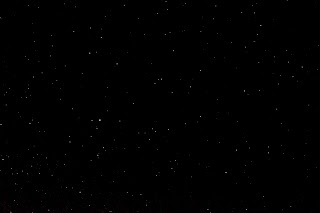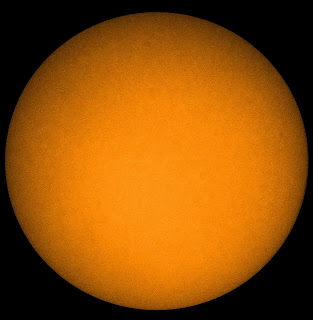May 31st 1240 GMT Sun
There was a small sunspot on the Learmonth images, so I did
a “formula” shot with my DSLR and filters at 300mm focal length, ISO 100 and
1/4000 second exposure.
May 30th 2250 GMT Meteor Hunt
I reverted back to my usual settings of 18mm focal length,
ISO 6400 and 6 seconds exposure. I aimed at Hercules, in the hope of catching a
rare Tau Herculid meteor. It was also high enough up to be a good place to
catch sporadic meteors, too.
I caught one early in the session at 2230 GMT and it fitted the path of a Tau Herculid perfectly.
I stacked 23 out of 30 frames to capture the constellations of Lyra, Hercules and Corona Borealis.
In the final shot, Lyra is the only constellation shown in its entireity.
May 30th 2100 GMT Venus
I checked the north western sky in the hope of seeing Venus
and/or Mercury. I saw Venus but, by the time I returned with my camera it had
gone. To be honest (I have to be because I am a bad liar!), I was not expecting
to see anything apart from a 100% phase.
May 30th 0100 GMT Moon
I was about to go to bed when I saw that the Moon had risen.
It was low, so I had a bit of trouble getting the exposure time right. I used
my normal settings of 300mm focal length and ISO 100 but used exposure times
between 1/200 and 1/80 second. No points for guessing that the longest exposure worked best.
May 29th 2200 GMT Deep Sky and Constellations
It was nice! Not only was there clear (well sort of) sky but
it was warm enough to do astrophotography in shorts and T-shirt. ( had decided
to experiment a bit with ISO settings, exposure times and focal length. Back in
2020, I was delighted to catch the global cluster M4 on camera for the first
time. It was my first target and I used various settings to catch it and hoped
that might get something useful.
I then went for M13 in Hercules, also hoping to improve on previous efforts.
One attempt failed but registered a meteor, possibly a Tau Herculid.
I was about to switch to constellation shots but saw Alpha
Persei above a neighbour’s house. Even knowing that it was very poorly placed,
I had to have a go and took a single set of shots at 300mm focal length, ISO
6400 and 1.6 seconds exposure. I only got one exposure to work and it caught the main stars but that was all.
I then switched lenses and set my camera to 18mm focal
length, ISO 800 and 30 seconds exposure. I used my intervalometer to attempt a
set of constellation shots of Bootes to see if I could improve on my effort
earlier in the month.
I stacked 30 frames. The northern parts had star trailing. Try to explain that one. Naturally, I cropped the image to show Bootes and Corona Borealis.
I tried stacking another set of images but there was star trailing, again. Undeterred, I tried processing a single frame instead, That was more like it.
May 27th 1120 GMT Sun
I had another go at photographing the Sun with my DSLR and
filters.
Unfortunately, I drew a blank on this effort, too!
I had a go at the Sun in hydrogen alpha light but, for some reason, I was struggling. Just one image worked and then not that well.
May 27th 0610 GMT Sun
May 25th 2040 GMT Moon
The Moon was only hours away from full and close to a lunar
eclipse that would not be visible from the UK. I snapped it at 300mm focal
length, ISO100 and 1/400 second exposure, maybe a bit too long.
May 25th 1145 GMT Sun
I had another go at photographing the Sun with the sane
setup as early morning. There was lots of cloud about, so I was glad to have
had my early morning session. Despite the cloud, I managed to snap the sunspot, although the result was horrible.
May 25th 0635 GMT Sun
I arrived at work and snapped the Sun with my DSLR and
filters at 300mm focal length, ISO 100 and 1/4000 second exposure.
May 23rd
May 23rd 2330 GMT Moon
There was a lot of moving cloud around but I caught the Moon
in a clear patch. I used 300mm focal length, ISO 100 and 1/320 second
exposure.
May 22nd 1120 GMT Sun
The weather had been unreliable for several days, offering
very little in the way of photographic opportunities. I had a brief spell of
sunshine that lasted for all of 10 minutes (or less). It gave me enough time to
snap the Sun in white light with my DSLR camera at 300mm focal length, ISO 100
and 1/4000 second exposure, with a Baader filter. As an added bonus, I could
even see a large sunspot in the camera viewfinder.
May 19th 1900 GMT Moon
The Moon was high in the south and the Sun was low. As I had
an early start at work the next day, I grabbed a bit of clear sky when I could
and I did not want to wait until later. Unusually, my most recent daylight moon
shots had been below par. I stayed with an exposure time of 1/200 second
exposure, with my usual daylight settings of 300mm focal length and ISO 400.
May 17th 1510 GMT Sun and Moon
Although, overall, the weather was bad, there were some odd
clear patches and caught one of them in the late afternoon.
I could not see much detail on the solar disc with my Coronado PST specialist solar telescope. I tried various combinations on focal lengths and exposure times, varying the ISO settings between 400 and 800, using my DSLR afocally and my PST at 27x magnification.
Th first reasonable shot was at ISO 800 1/15 second and 40mm focal length. It turned out to be the ONLY reasonable shot.
I snapped the Moon directly using my DSLR at 300mm focal
length, ISO 400 and 1/200 second exposure. I caught some detail on the lunar disc but was not pleased with the result.
May 15th 2010 GMT Moon
There had been a lot of rain and cloud, as in the preceding days. I walked our dogs and saw the crescent moon high in the west. I looked for Mercury and Venus but did not see either. When I returned home, I snapped the Moon at 300mm focal length, ISO 100 and 1/200 second exposure. It was my first live action for 6 days.
May 14th Deep Sky Photos Reprocessed 17th January 2020
May 13th Solar Image Reprocessed 17th January 2019
May 12th Lunar Image Reprocessed 19th May 2019
May 12th Lunar Image Reprocessed 15th May 2019
May 12th Solar Hydrogen Alpha Image Reprocessed 15th May 2019
May 11th Solar Image Reprocessed 15th May 2019
May 9th 1130 GMT Sunspot Drawing
May 8th
I reprocessed a solar hydrogen alpha shot from March 16th 2019. I obtained more detail than the original but it was not a classic.
I also reprocessed a lunar shot from March 17th 2019. I used a different capture method then. with a high ISO and very short exposure. Despite that, was quite pleased with the result.
May 5th 0600 GMT Moon
Being of smaller phase, the Moon was much harder than the evening before, so I increased the exposure time to 1/200 second.
May 4th 2100 GMT Betelguese
Betelguese was above the horizon but the only comparison
star visible was Procyon. However Betelguese was so near the horizon that any
attempt at estimating its brightness would be unreliable.
I therefore concluded that the Betelguese season had ended, at least for me and anyone observing from a similar latitude (51.4 Degrees North).
May 4th 0630 GMT Moon
The Moon was in the south and just past last quarter. I
snapped it at 300mm focal length, ISO 400 and 1/250 second exposure.
May 3rd
May 2nd 1030 GMT Sun
The Learmonth and Big Bear images showed a quiet Sun, even in hydrogen alpha light. However, it was a non-working day and the Sun was out, at least for a while. I decided to experiment with an ISO setting of 400 and varied the focal length and exposure times to see what I could come up with.
The first shot caught only part of the solar disc, despite using a short focal length.
May 2nd 0000 GMT Constellations
I had hoped for some clear sky earlier in the evening, as I
wanted another go at the Beehive cluster (M44) before it was lost for another
year. Conditions cleared somewhat but were less than perfect. I went back to my
usual constellation settings of 18mm focal length, ISO 400 (I would have gone
to ISO 800 without the haze) and 30 seconds exposure.
I took one set of frames of Bootes. I had a nice shot of Corona Borealis within it and caught the subject of the next set of frames to the lower right: the star cluster Melotte 111 that looks a bit like a running man. The original photo was quite faint, so I used the Exposure function quite liberally in GIMP to bring out more detail.
I took another set of frames aimed between Bootes and Leo,
in the hope of capturing a widefield view of Melotte 111. I did but apart from catching Leo's backside, it showed nothing more than the previous photo,

















































No comments:
Post a Comment